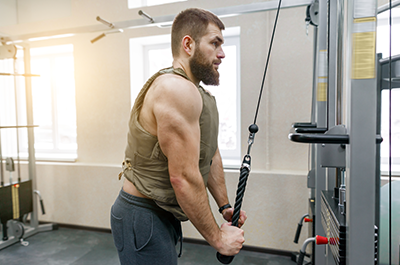Don’t have the time or money to join a gym? Don’t worry! There are plenty of ways you can work your muscles from the comfort of your own home without overspending. In fact, you can create an entire home workout circuit by purchasing exercise equipment on the cheap or using props that are already part of your home (stairs and benches are prime examples).
Get Creative
This time of the year is a great time to outfit your home gym. A number of manufacturers or sporting goods stores may be offering holiday specials or free shipping. That can mean steep discounts when you’re purchasing gym equipment.
You don’t necessarily need to buy from a fitness equipment store, either. Facebook Marketplace and other group exchange sites can connect you with people who are ditching gently used items. While you may pay more money up front building your home gym, you’ll avoid the long-term cost of a monthly gym membership.
Not sure which home gym essentials you should spring for first? In general, look for equipment you can use to work several different muscle groups. A few ideas:
- Resistance bands: These stretchy elastic bands are easy to stow away when you’re not using them. They come in different sizes, lengths, strengths and resistance levels. Choose a band with mid-level resistance so you can use it for different exercises. Better yet, get help from a fitness pro to determine which band is best for your goals.
- Pull-up bars: Pull-ups are one of the simplest exercises you can do (use your arms to lift your body up to a bar and then lower yourself back down) but they’re very effective for building upper body strength. Pull-up bars are inexpensive, and if you bolt them to the wall correctly, they may even last a lifetime.
- Dumbbells: The benefits of owning a set of dumbbells can’t be overstated. Inexpensive, easy-to-use hand weights work well for a variety of workouts. Depending on the weight you choose and the number of repetitions you do, working with dumbbells can improve both strength and endurance. Plus, even a single dumbbell can boost your fitness level with exercises like the one-arm overhead press or goblet squat.
- Kettlebell: The kettlebell has become a standard training tool for personal trainers. These cast-iron balls with a handle range in weight from 5 to 100 pounds. Using a kettlebell is an easy way to get your heart pumping without cardiovascular movement.
- Stability ball: A stability ball takes up a lot of space, but it’s also a great way to work every muscle in your body, including your abs, hips, thighs and calves. Whether you’re performing abdominal exercises, doing pushups on it or using it as a weight bench, the ball helps you target your core muscles for a more challenging workout.
- Plyometrics boxes: Plyometric boxes, or plyo boxes, are inexpensive — and they’re easy to make if you have a “do-it-yourself” mentality. They’re basically just a wooden box you can use as a platform to perform exercises, such as box jumps, step-ups and elevated pushups.
Keep it Simple
No matter which equipment you choose, your body will adapt to the demands you place on it. In order to build strength and endurance, you have to be willing to work your muscles to their maximum potential.
Don’t want to invest in home gym equipment? You can get a workout by flipping a tire, lifting gallon milk jugs or breaking out your old jump rope.
Keep it Safe
If you’re springing for heavy, durable equipment like barbells and plates or pull-up bars, do your home a favor and make sure they’re installed and stored correctly. Otherwise, you run the risk of damaging your home’s floors, walls or foundation.
Home workouts are a great way to save time and money, but it’s important to make sure you know what you’re doing and that you use correct form. Your best bet to achieve that end: Work with a fitness professional for a few sessions and come up with a routine that’s safe and effective.
To find a doctor or athletic trainer at Henry Ford, visit henryford.com or call 1-800-HENRYFORD (436-7936).
Nick Parkinson, M.Ed., ATC, AT, currently works with the student athletes at University of Detroit Jesuit High School, as well as serving in the role of Lead Athletic Trainer with Henry Ford Sports Medicine. He is a regular contributor to Henry Ford LiveWell. Learn more about Nick.



